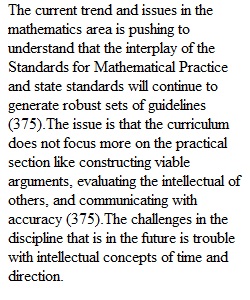


Q Purpose: Graduate students will individually explore, examine, and critically evaluate foundational and current trends and issues in curriculum design and implementation. Clarifying, descriptive, and probing questions related to the required texts and resources provided will be in a reflective, “module reading outline” that will be submitted as a PDF by the due date indicated in Blackboard. Instructions: Answer the questions related to the module outline topics, readings, and resources. a. Reponses should be in a different color than the questions (no answers in black font). b. If specific quotes are highlighted or shared in a response, the quote needs to have a citation/reference in APA (please refer to the 7th edition rules). c. Once the questions have been answered, save the document as a PDF, and submit the completed PDF document in Blackboard by the due date. Structure: There are three (3) sections of the module outline: 1) Textbook/Resource Questions 2) Research Extension Questions 3) Reflection Questions Please ensure that you have answered all questions in all sections before submitting the document to Blackboard! Grading Criteria: Your final score (out of 7 points) will be based on the level and depth of description, examination, evaluation, and reflection of the questions posed by the guiding questions (see below). The rubric will guide you in the evaluation of the module. Note: Although the module outline is not due until the end of the two-week module date on the tentative course calendar, it is strongly suggested to complete the module before the initial blackboard posting as this outline will be helpful in structuring and composing your initial post and responses to peers. ------- The question(s) below refer to the Glatthorn et al. textbook – Chapters 13-14: Pages 358-424 1. In Chapter 13, locate your discipline area (if your area is not highlighted in the textbook, you can choose an area that is interesting to you OR you may find an outside source to answer the questions): 1) English, Language Arts, Reading and Writing – p. 358 2) History-Social Studies – p. 370 3) Mathematics – p. 374 4) Science – p. 378 5) Foreign Language – p. 381 6) Art Education – p. 384 7) Physical and Health Education – p. 388 8) Multicultural Education – p. 389 a) Describe the current trends and issues in your discipline area. b) What are the current challenges in your field, related to curriculum design and implementation? c) What changes to your discipline do you see in the future?2. In Chapter 14 (and Chapter 15), the authors mention learning styles. “Learning Styles” as it is often used, currently, in schools is NOT based on research or evidence. In other words, learning styles is an education myth. In this textbook, learning styles is defined as students’ preferences when engaged in the learning process. The key word here is preference. Learning styles, at best, is a preference and anything more than that is not supported by research. Read “The Myth of Learning Styles” practitioner article published in The Magazine of Higher Learning by Cedar Riener and Daniel Willingham (PDF of the article is in the Module 5 Resource Folder). a) Why learning is styles an “education myth”? This is because of the claim that “different students have different modes of learning, and their learning could be improved by matching one’s teaching with that preferred learning mode”(Riener&Riandoph 33) Why is the concept of learning styles pervasive in K-20 education contexts?
Q c) What are the issues regarding curriculum and learning styles – how might learning styles detract from curriculum design and implementation? 3. On page 396, the authors state “We need to teach not only the facts but teach how the facts relate to our global world” (Glatthorn, et al., 2019). Do you agree with this statement? Why?
View Related Questions